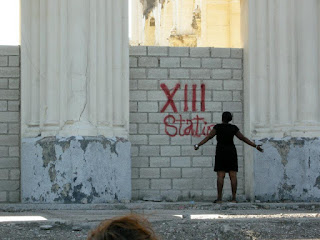Preached on April 15, 2012 at First Congregational Church of Tallmadge, UCC.
Scripture Acts
4:32-37
Now
the whole group of those who believed were of one heart and soul, and no one claimed
private ownership of any possessions, but everything they owned was held in
common. With great power the apostles gave
their testimony to the resurrection of the Lord Jesus, and great grace was upon
them all. There was not a needy person among them,
for as many as owned lands or houses sold them and brought the proceeds of what
was sold. They laid it at the apostles’ feet,
and it was distributed to each as any had need. There was a Levite, a native of
Cyprus, Joseph, to whom the apostles gave the name Barnabas (which means “son
of encouragement”). He
sold a field that belonged to him, then brought the money, and laid it at the
apostles’ feet.
Sermon
It is
only a very short time between the evening of his resurrection when Jesus
visits the disciples in that locked room and the day when the disciples are
leading people who share one heart and soul and all that they possess. Disciples hiding out in a locked room, and
then, with the courage and passion of the risen Lord burning inside of them,
they are described in the book of Acts giving, with great power, testimony to
the resurrection of the Lord Jesus.
Testimony
to the resurrection. Some of that
testimony was in words, telling the story.
But what gave their testimony power is what it says in the very next
line. “There was not a needy person
among them.” With great power the
apostles gave their testimony to the resurrection of the Lord Jesus. There was not a needy person among them. And I believe that the strength of their
testimony, the reason it was convincing and compelling to others, was in the
simple fact that there was not a needy person among them.
The Roman
empire in which they lived was a society of extreme inequality. The empire had great wealth, and built
incredible structures that we marvel at to this day, but they were built on the
backs of the poor. In the empire,
especially in Israel, there were needy people everywhere. Right in the middle of that context, here is
a group of people who share all things in common so that there is not a needy
person among them. Some people needed
help, and others were well off, so their wealth was distributed among those who
had need. What a powerful alternative
was the kingdom of God, a place of common good.
It was testimony to the resurrection.
Next
month, I will travel once again to Boston with the 9th grade
students of the Confirmation class, because that is the birth place of the
Congregational Church. We will visit the
historic places of the Pilgrims who founded Plymouth, and the Puritans who came
a few years later to Boston Harbor and created that city, and also Cambridge,
and the first college of the colonies, called Harvard. Those early Congregationalists had in mind to
do something very similar to the church in the book of Acts. They came to create an intentional colony, an
alternative society to the inequality of the corrupted European society.

John
Winthrop was a leader of the Puritans in the Massachusetts Bay Colony, and he
is perhaps best remembered for calling this new society a “City on a Hill” in a
sermon he gave on the boat that took them to America. City on a Hill – the phrase is often used
these days as if it meant that America is especially blessed by God because of
our unique qualities. But that wasn’t
what Winthrop was saying. The sermon in
which he used this phrase was titled “A Model of Christian Charity. He was telling his fellow Puritans that they
would create a society guided by charity toward one another, especially toward
those whose need is greatest. He posed
the question “what rule must we observe [for those] in peril?” And he answered “To give out of one’s
abundance, but with more enlargement towards others and less respect towards
ourselves.”
And then
he said “we shall be a city on a hill.
The eyes of all people are upon us.”
In other words, people will see if there are or are not needy people
among us. They will see if we fail in
the care of those most in need, most vulnerable, and if we fail, what kind of
testimony would that be? It would not be
testimony of the resurrection.




